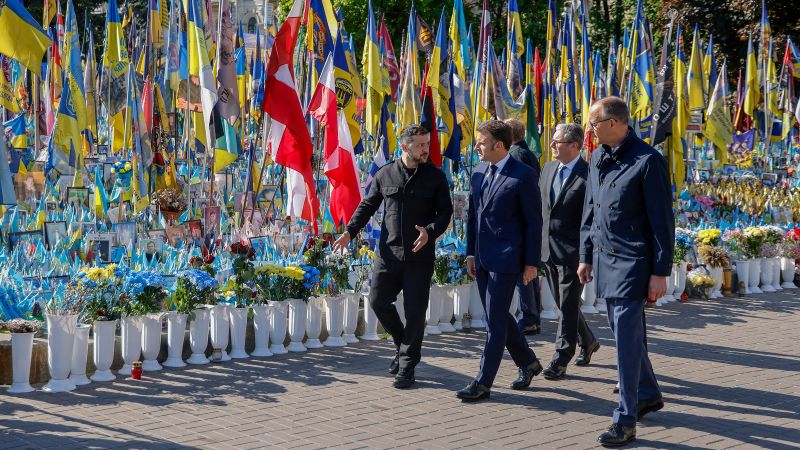European leaders are grappling with a proposal for a 30-day ceasefire in Ukraine, which forces the Kremlin into a difficult position regarding its ongoing war. This initiative, backed by the U.S., aims to pause Russian aggression amid escalating violence. Key figures like French President Macron and Ukraine’s President Zelensky advocate for the plan, while stressing the need for U.S. involvement in monitoring compliance and enacting severe sanctions if necessary. Despite hopes for peace, there are doubts about Putin’s willingness to engage genuinely. The upcoming weeks will be crucial in determining the conflict’s trajectory and securing U.S. support for Ukraine.
Kyiv, Ukraine
CNN
—
This is a proposal that the Kremlin cannot simply accept or reject, yet it may compel them into a difficult decision, unveiling Russian President Vladimir Putin’s genuine intentions regarding his aggressive warfare.
Leaders across Europe are confronting the challenging reality of whether peace negotiations concerning Ukraine could yield substantial outcomes, particularly as Moscow appears to be intensifying its military actions with the summer approaching.
Furthermore, it places Ukraine, Europe’s largest military force, in the position of having slightly over 30 hours to ready their troops for potentially a month of precarious calm, followed by hopefully extensive negotiations that would determine their national borders.
In the end, Ukraine, France, the UK, Germany, and Poland had little alternative: the Trump administration’s overt signs of impatience – often directed at Moscow, but unjustly toward Kyiv as well – posed the risk of the White House simply “moving forward.” This could lead to the US withdrawing support from Ukraine, jeopardizing their efforts for a peaceful resolution – a potential disaster for European stability.
The significant diplomatic exertions over the past week from French President Emmanuel Macron, UK Prime Minister Keir Starmer, and Ukrainian President Volodymyr Zelensky himself have pressured the White House into endorsing a direct European initiative to shape the outcome of the continent’s most significant conflict since the 1940s.
Europe is, in fact, compelling Russia to consider a proposal initially put forth by the US and Ukraine – an unconditional 30-day ceasefire originally suggested after bilateral discussions in Saudi Arabia nearly two months ago. They are also compelling the White House to enhance its role in monitoring the truce and to implement stringent repercussions – which Macron referred to as “massive sanctions” – should the initiative fail.
The Kremlin can no longer respond with its prior line of “let’s discuss the nuances.” They must either agree to, challenge, or disregard this proposal. Based on past observations, a convoluted response is likely.
While Russia might concede to the pause, they could orchestrate an uptick in violence, blaming the Ukrainians for instigating it. Alternatively, they may contest specific facets of the proposal—such as retaliating solely against Ukrainian forces within Russia’s Kursk or Belgorod regions—prompting the White House to reconsider its response to Moscow’s selective compliance with the ceasefire. There’s a chance that Moscow might altogether ignore the proposal, leveraging the strategy of a Trump-Putin conversation to reassess their position in this challenging scenario.
This moment represents a crucial diplomatic juncture in the conflict, probably the most critical statement thus far, and certainly the most significant 36 hours since Putin faced unrest from his top advisor Yevgeny Prigozhin in June 2023. Urgency is a critical concern: something intended to last 30 days must be fashioned within just 30 hours.
Vast uncertainties linger for Ukraine and its allies regarding how this ceasefire will be implemented. Is it feasible for Kyiv to instruct its forces to refrain from engaging in self-defense? If the US is to oversee the ceasefire, as Macron indicated, does it possess the necessary resources to effectively monitor the extensive and volatile frontlines? Accurate data on Moscow’s violations will be vital in assisting Ukraine and Europe in countering the inevitable surge of Russian misinformation and accusations that are likely to accompany any ceasefire.
The implications for Kyiv and Europe in the coming month could be substantial. Ukraine may find itself ceding territory as its forces lighten their responses to Russian aggression during the ceasefire. The White House might emerge from this process pivoting back to a place where it perceives Zelensky as the obstacle. The remarkable unity displayed by Europe today in Kyiv, supported by over a dozen nations from New Zealand to Canada, could easily deteriorate from its current peak, especially if American support for Ukraine diminishes.
However, the cost of inactivity – much like in 1930s Europe – could be even greater. If Trump loses his patience with what may be the most intricate issue under his purview, it could severely harm Kyiv more than Moscow. Allowing Putin another two months to erode Kyiv’s defenses could lead Zelensky to face yet another brutally harsh winter.

Ukraine and its European allies strive for clarity on whether Putin genuinely seeks any form of peace. The approach they have taken is itself vague and laden with potential pitfalls stemming from Putin’s manipulation tactics.
Observing the leaders of Europe’s five largest militaries in Kyiv on Saturday, it seemed evident that most concluded that Putin is not interested in peace and is unlikely to genuinely consider a month of it. These five leaders now face a challenging few weeks to confirm this reality, while also navigating the task of convincing Trump to adopt a more hardline stance on Russia than his predecessor, Joe Biden.
The trajectory that Europe’s leaders seem to foresee involves an escalation of hostilities – where Putin breaches a ceasefire, faces “massive sanctions,” and Europe is required to intensify its military support for Ukraine. They seem to doubt that the Kremlin desires a cessation of the conflict. The upcoming weeks appear designed to ultimately prove to Trump that he is being misled, and to integrate his White House firmly into their alliance.
